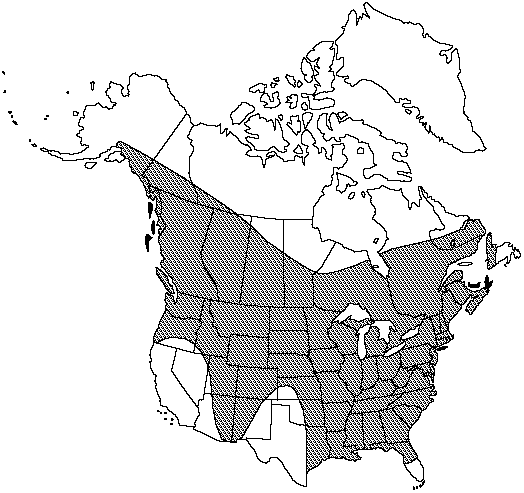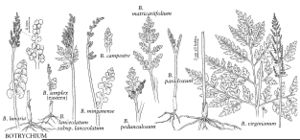Difference between revisions of "Botrychium virginianum"
J. Bot. (Schrader) 1800(2): 111. 1801.
FNA>Volume Importer |
FNA>Volume Importer |
||
| Line 20: | Line 20: | ||
}}<!-- | }}<!-- | ||
| − | --><span class="statement" id="st- | + | --><span class="statement" id="st-undefined" data-properties=""><b>Trophophore </b>sessile; blade pale green, 3–4-pinnate, to 25 × 33 cm, thin, herbaceous. <b>Pinnae</b> to 12 pairs, usually approximate to overlapping, slightly ascending, distance between 1st and 2d pinnae not or slightly more than between 2d and 3d pairs, lanceolate, divided to tip. <b>Pinnules</b> lanceolate and deeply lobed, lobes linear, serrate, apex pointed, venation pinnate, midrib present. <b>Sporophores</b> 2-pinnate, 0.5–1.5(–2) times length of trophophore. <b>2n</b> =184.</span><!-- |
-->{{Treatment/Body | -->{{Treatment/Body | ||
| + | |phenology=Leaves seasonal, appearing in early spring and dying in late summer. | ||
|habitat=Common to abundant, especially in shaded forests and shrubby second growth, rare or absent in arid regions | |habitat=Common to abundant, especially in shaded forests and shrubby second growth, rare or absent in arid regions | ||
|elevation=0–1500 m | |elevation=0–1500 m | ||
| Line 42: | Line 43: | ||
|basionyms=Osmunda virginiana | |basionyms=Osmunda virginiana | ||
|family=Ophioglossaceae | |family=Ophioglossaceae | ||
| + | |phenology=Leaves seasonal, appearing in early spring and dying in late summer. | ||
|habitat=Common to abundant, especially in shaded forests and shrubby second growth, rare or absent in arid regions | |habitat=Common to abundant, especially in shaded forests and shrubby second growth, rare or absent in arid regions | ||
|elevation=0–1500 m | |elevation=0–1500 m | ||
| Line 49: | Line 51: | ||
|publication year=1801 | |publication year=1801 | ||
|special status= | |special status= | ||
| − | |source xml=https://jpend@bitbucket.org/aafc-mbb/fna- | + | |source xml=https://jpend@bitbucket.org/aafc-mbb/fna-data-curation.git/src/9216fc802291cd3df363fd52122300479582ede7/coarse_grained_fna_xml/V2/V2_31.xml |
|genus=Botrychium | |genus=Botrychium | ||
|subgenus=Botrychium subg. Osmundopteris | |subgenus=Botrychium subg. Osmundopteris | ||
|species=Botrychium virginianum | |species=Botrychium virginianum | ||
| − | |||
| − | |||
| − | |||
| − | |||
| − | |||
| − | |||
| − | |||
| − | |||
| − | |||
| − | |||
| − | |||
| − | |||
| − | |||
| − | |||
| − | |||
| − | |||
| − | |||
| − | |||
| − | |||
}}<!-- | }}<!-- | ||
-->[[Category:Treatment]][[Category:Botrychium subg. Osmundopteris]] | -->[[Category:Treatment]][[Category:Botrychium subg. Osmundopteris]] | ||
Revision as of 14:16, 27 July 2019
Trophophore sessile; blade pale green, 3–4-pinnate, to 25 × 33 cm, thin, herbaceous. Pinnae to 12 pairs, usually approximate to overlapping, slightly ascending, distance between 1st and 2d pinnae not or slightly more than between 2d and 3d pairs, lanceolate, divided to tip. Pinnules lanceolate and deeply lobed, lobes linear, serrate, apex pointed, venation pinnate, midrib present. Sporophores 2-pinnate, 0.5–1.5(–2) times length of trophophore. 2n =184.
Phenology: Leaves seasonal, appearing in early spring and dying in late summer.
Habitat: Common to abundant, especially in shaded forests and shrubby second growth, rare or absent in arid regions
Elevation: 0–1500 m
Distribution

Alta., B.C., Man., N.B., Nfld., N.W.T., N.S., Ont., P.E.I., Que., Sask., Yukon, all states except Calif., Mexico, Central America, South America in Brazil, Colombia, Ecuador, Peru, Eurasia.
Discussion
Botrychium virginianum is the most widespread Botrychium in North America.
Selected References
None.
